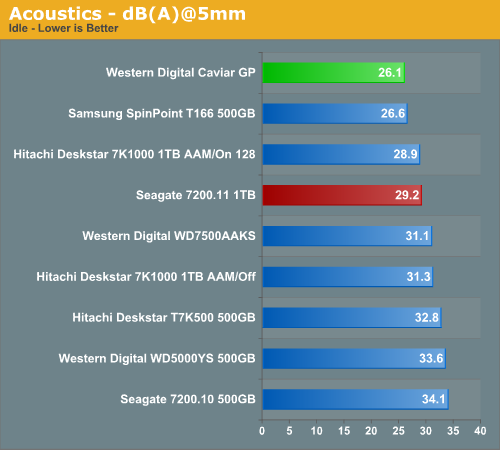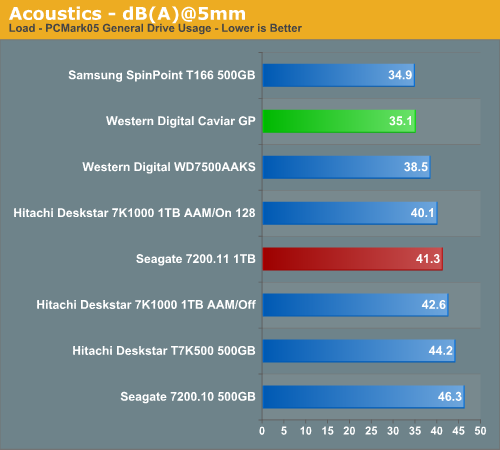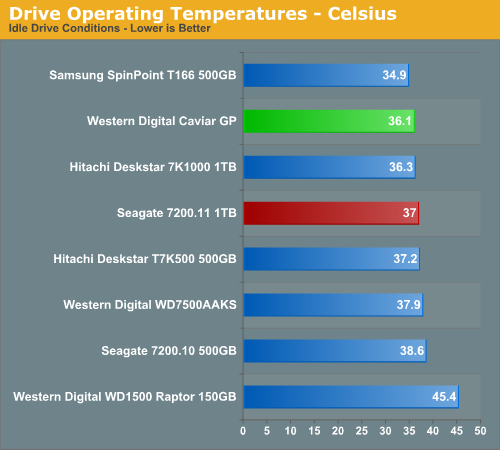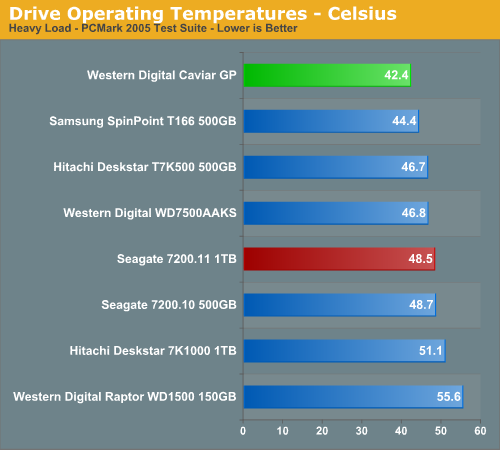Seagate and Western Digital 1TB Drives: Improved and Green
by Dave Robinet on November 26, 2007 7:00 AM EST- Posted in
- Storage
Acoustics
Our test methodology for acoustics has changed. Rather than checking the drive inside the case with components, we use an external USB-SATA converter cable to run the drive to a different physical room to take our measurements. While the conversion to USB does reduce the performance level of the drive during the test, it leaves the noise characteristics unchanged. The drive sits atop a small brick of acoustical sponge material to keep it raised from the floor without introducing additional vibration. We take measurements at a distance of 5mm from the rear and front of the drive. These precautions, whose results on earlier drives confirm the accuracy of our previous methodology, will further reduce the likelihood of ambient noise from the PC interfering with our results.
Our acoustic tests measure the decibel levels while the system is at idle and under load while running the General Hard Disk Drive Usage benchmark within PCMark 2005. We found through trial and error that this particular benchmark produces controlled readings across a wide range of applications within the benchmark. This particular benchmark utilizes 60% reads and 40% writes within the trace playback file.
We report measurements based on an A-weighted decibel score that measures frequencies similar to the way the human ear responds to sound. We take three measurements for each test. We then subtract the high and low scores and arrive at our findings by reporting the remaining score. The test room has a base acoustical level of 20dB(A).


The idle noise level of the Caviar GP is impressive, owing to the lower rotational speed of the drive due to its power saving technology. At load, however, the drive is slightly louder than the Samsung T166. The Seagate 7200.11 drive turns in middling results in both tests.
Thermals
Our thermal tests utilize sensor readings via the S.M.A.R.T. (Self-Monitoring, Analysis and Reporting Technology) capability of the drives as reported by utilizing the Active SMART 2.6 utility. We also utilize thermal sensors and infrared measurement devices to verify our utility results. We test our drives in an enclosed case environment without the fans operational to simulate temperatures that conceivably exists in a near-silent SFF or HTPC case design. We typically find the reported numbers drop anywhere from 14% to 25% with the case fans operational. Our base temperature level in the room at the time of testing is 25C.


Here is where we see the Caviar GP shine. The temperature reading of 42.4C under load is the coolest conventional drive we have tested, coming in even cooler than the Samsung T166. The Seagate 7200.11 produces comparatively little heat at idle, but warms quickly under load, finishing near the hottest drives we have tested.










31 Comments
View All Comments
jojo4u - Monday, November 26, 2007 - link
IBM is varying the spindle speed (Low RPM Standby mode). But only after quite an amount of idle. http://www.silentpcreview.com/article304-page2.htm...">http://www.silentpcreview.com/article304-page2.htm...